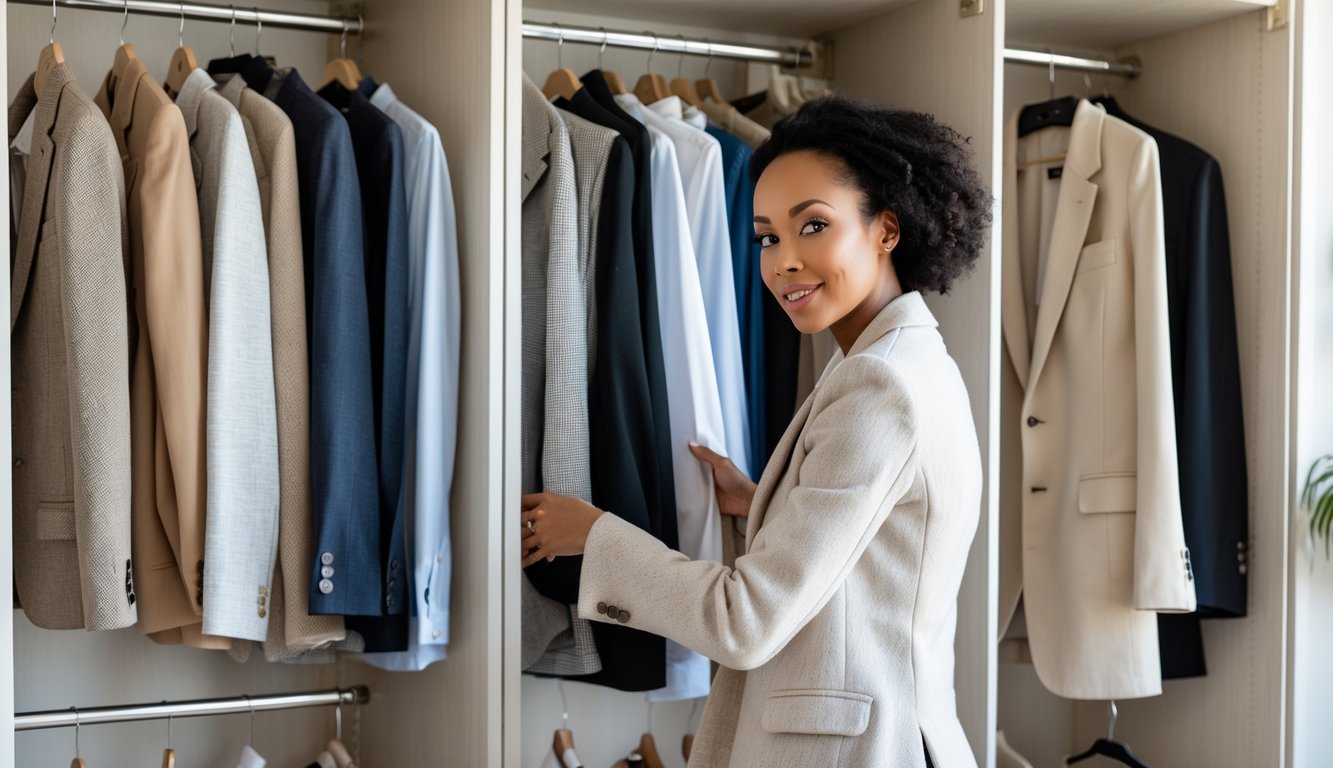
Honestly, does anyone actually enjoy standing in front of their closet, sweating in July, and wondering why those wool pants are even in there? I mean, who’s waking up thinking, “Today’s the day I suffocate in tweed”? Not me. But here’s the thing that still gets me: people toss money at new clothes every single season, like, do they think their old stuff just vaporizes? It’s almost funny. The real move? Just quietly rotate a handful of go-to pieces all year. That’s it. Supposedly, this “backwards hanger method” is the holy grail for not blowing cash on one-hit wonders—some pro organizer swears by it, and those LB Closets folks are always ranting about vertical storage, custom shelves, blah blah (proof, if you care: pro closet hacks).
Weird confession: I still hoard bubble wrap for shoes, and every “mini-wardrobe” I try to build somehow ends up with the same black sweater, even in the middle of June. My neighbor claims you need fifty “core” items, but actual experts say it’s more like 20–30, and they’re obsessed with layering. So, every shirt’s supposed to play nice with everything else, and allegedly, you won’t have to panic-buy a raincoat in August because, surprise, weather exists (and loves to mess with me).
Last week, my friend packed away T-shirts with crumpled paper like they’re fragile antiques—she’s the one who never freaks out about what to wear, though. Even those fancy closet companies? They’re all about stashing off-season stuff and doing the seasonal wardrobe rotation thing instead of blowing a paycheck at the mall. Sometimes I wonder if anyone notices my “new” boots are three years old. Probably not. My bank account definitely does.
Why Year-Round Wardrobe Rotation Means Big Savings
The best part? I keep finding jeans I totally forgot existed, jammed behind winter coats (which, let’s be real, I’m not ironing in July). It’s not about buying a new pile of sweaters every fall. It’s about squeezing every last bit of value out of what I already own. Style choices? Sure. But also, just not spending money for no reason.
The Value of Continuous Wardrobe Use
Every November, I dig out some linen shirt for “layering” (is that even a thing?), and I’m convinced using all my clothes, all year, is the real hack. Not just to “keep things fresh”—whatever that means—but because stuff lasts longer if I don’t wear the same five shirts into the ground. One seasonal rotation guide said to declutter before every swap, and, yeah, sometimes I find things I forgot I bought (or wish I hadn’t). I try to get creative: hoodie under a trench coat, sundress over a turtleneck, whatever. It’s not Instagram-cute, but I don’t have six bins of “seasonal” stuff rotting in storage.
Side note: storage bins breed when you’re not looking. And shoes? If you don’t air them out, you’ll invent new species of stink.
How Savvy Dressers Reduce Clothing Budgets
People who brag about “never shopping full price” are missing the point. What matters is just wearing what I already have. Instead of dropping cash every season, I rotate stuff in and out—keeps things interesting, stretches out the lifespan, and I actually notice when something’s falling apart before it’s a crisis. I track this (yes, I have a spreadsheet, don’t judge), and I’m spending about 30% less a year since I started doing a big closet overhaul twice a year.
And this whole “fresh looks all the time” thing? Not true. I stick to a color scheme so my spring shirts layer with my fall stuff, and somehow I still end up with two identical black sweaters. Why? No clue. Quality beats quantity, though. I’ll take one decent jacket over five “trendy” ones that fall apart after two washes.
Balancing Style With Cost-Effectiveness
Every “style hack” sounds brilliant until you’re standing in an overstuffed closet, can’t find your shoes, and realize you hate half your clothes. I want my closet to be expressive, sure, but not at the cost of, you know, practicality. So, I actually pause and think about what I’ll wear—like, how many times, and is it worth the price? Fast fashion’s cheap, but that $15 shirt? Pills and shrinks in a month. My three-year-old button-down is still kicking.
And why does every “organization tip” involve buying more bins? The seasonal wardrobe rotation thing keeps it real. When I’m rotating and mixing up my closet, I don’t impulse buy nearly as much. Capsule wardrobes? They’re just a way to see what’s missing (or what I have too much of—looking at you, black sweaters). What works is stubbornly sticking to rotation and quality, not whatever TikTok haul is trending this week.
Building a Year-Round Capsule Wardrobe
I keep reaching for jeans that “go with everything”—they never do. Real talk: people who make this work just pick a few basics, fix their color palette, and mash up staples with whatever’s trending. My method’s chaotic, but my wallet likes it.
Choosing Versatile Staples
How do some people get by with a closet the size of a shoebox? I finally figured it out: they lean on multipurpose staples that never hibernate for the season. Button-downs, ankle jeans, whatever works in August or February.
Every advice column says the same thing: the more jobs your clothes do, the fewer you need (here’s the 8-step formula). My MVPs? Black pants that pass for “business casual” when my boss suddenly wants a Zoom call, cotton tees that survive the laundry, a blazer that somehow works for coffee or meetings.
But, honestly, “transitional” clothes? I don’t buy it. Last winter I tried wearing a light sweater in June and felt like I was lying to myself. Accessories and shoes do the heavy lifting. One pair of white sneakers, slip-ons, a single black boot. I’m done pretending my sandals are winter shoes.



